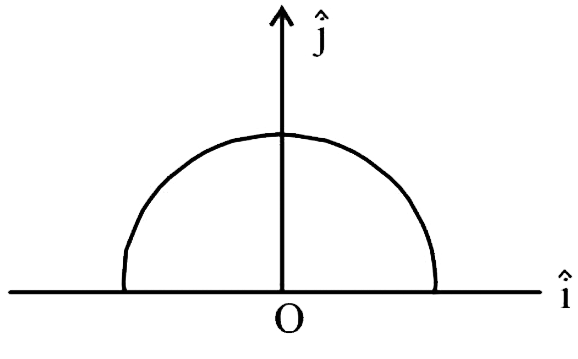A rubber balloon is given a charge Q distributed uniformly over its surface. Is the field inside the balloon zero everywhere if the balloon does not have a spherical surface?
To determine whether the electric field inside a rubber balloon (which is a non-conductive material) with a charge Q uniformly distributed over its surface is zero everywhere, we can apply Gauss's Law. Here’s a step-by-step solution:
Step 1: Understand the Problem
We have a rubber balloon that is charged uniformly on its surface. We need to find out if the electric field inside the balloon is zero everywhere, especially considering that the balloon does not have a spherical shape.
Step 2: Identify the Nature of the Balloon
Since the balloon is made of rubber, which is a non-conductive material, the charge Q will reside on the surface of the balloon. This is a key point because in conductors, charges can move freely, but in non-conductors, the charges remain fixed in place.
Step 3: Apply Gauss's Law
Gauss's Law states that the electric flux through a closed surface is proportional to the charge enclosed by that surface. Mathematically, it is given by:
ΦE=∮→E⋅d→A=Qinϵ0
where ΦE is the electric flux, →E is the electric field, d→A is the differential area vector, Qin is the charge enclosed by the Gaussian surface, and ϵ0 is the permittivity of free space.
Step 4: Choose a Gaussian Surface
To analyze the electric field inside the balloon, we can choose a Gaussian surface that is located just inside the surface of the balloon. This surface can take any shape, but it must be entirely within the balloon.
Step 5: Determine the Charge Enclosed
Since the charge Q is distributed only on the surface of the balloon, the charge enclosed by our Gaussian surface (which is inside the balloon) is zero:
Qin=0
Step 6: Calculate the Electric Field
Substituting Qin=0 into Gauss's Law gives us:
∮→E⋅d→A=0ϵ0=0
This implies that the electric flux through the Gaussian surface is zero. For the electric flux to be zero, the electric field →E inside the balloon must also be zero everywhere:
→E=0
Conclusion
Thus, the electric field inside the rubber balloon is zero everywhere, regardless of the shape of the balloon.
---
We have a rubber balloon that is charged uniformly on its surface. We need to find out if the electric field inside the balloon is zero everywhere, especially considering that the balloon does not have a spherical shape.
Since the balloon is made of rubber, which is a non-conductive material, the charge Q will reside on the surface of the balloon. This is a key point because in conductors, charges can move freely, but in non-conductors, the charges remain fixed in place.
Gauss's Law states that the electric flux through a closed surface is proportional to the charge enclosed by that surface. Mathematically, it is given by:
To analyze the electric field inside the balloon, we can choose a Gaussian surface that is located just inside the surface of the balloon. This surface can take any shape, but it must be entirely within the balloon.
Since the charge Q is distributed only on the surface of the balloon, the charge enclosed by our Gaussian surface (which is inside the balloon) is zero:
Substituting Qin=0 into Gauss's Law gives us:
Thus, the electric field inside the rubber balloon is zero everywhere, regardless of the shape of the balloon.
Topper's Solved these Questions
Similar Questions
A rubber balloon is given a charge Q distributed uniformly over its surface. Then
View SolutionA spherical shell made of plastic, contains a charge Q distributed uniformly over its surface. What is the electric field inside the shell? If the shell is hammered to deshape it without altering the charge. Will the field inside be changed? What happend if the shell is made of a metal?
View SolutionA spherical conductor of radius 12 cm has a charge of 1.6×10−7C distributed uniformly on its surface. What is the electric field (a) inside the sphere (b) just outside the sphere (c ) at a point 18 cm from the center of the sphere ?
View SolutionA thin disc of radius R has charge Q distributed uniformly on its surface. The disc is rotated about one of its diametric axis with angular velocity ω. The magnetic moment of the arrangement is
View SolutionA thin semi-circular ring of radius r has a positive charge q distributed uniformly over it. The net field →E at the centre O is

View SolutionA ring of radius a contains a charge q distributed. uniformly ober its length. Find the electric field at a point. on the axis of the ring at a distance x from the centre.
View SolutionA hollow tube is carrying an electric current along its length distributed uniformly over its surface. The magnetic field
View SolutionA sphere carries a uniformly distributed electric charge. Prove that the field inside the sphere is zero
View SolutionA ring of radius R has charge −Q distributed uniformly over it. Calculate the charge that should be placed at the center of the ring such that the electric field becomes zero at apoint on the axis of the ring at distant R from the center of the ring.
View SolutionA cjircular wire-loop of radius a carries a total charge Q distributed uniformly over its length . A small length dL of the wire is cut off. Find the electric field at the centre due to remaining wire.
View Solution
